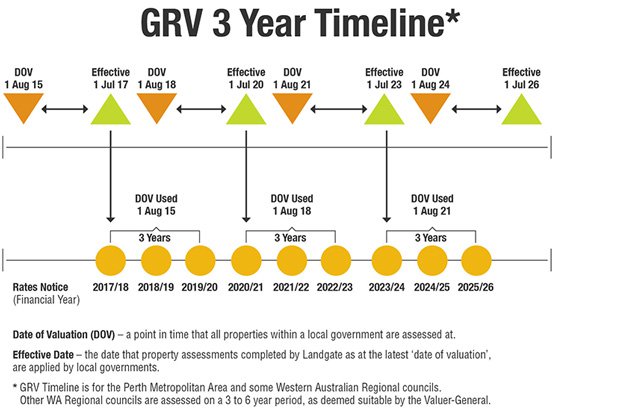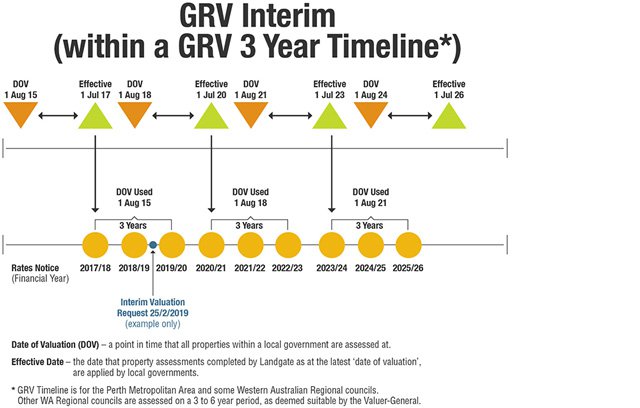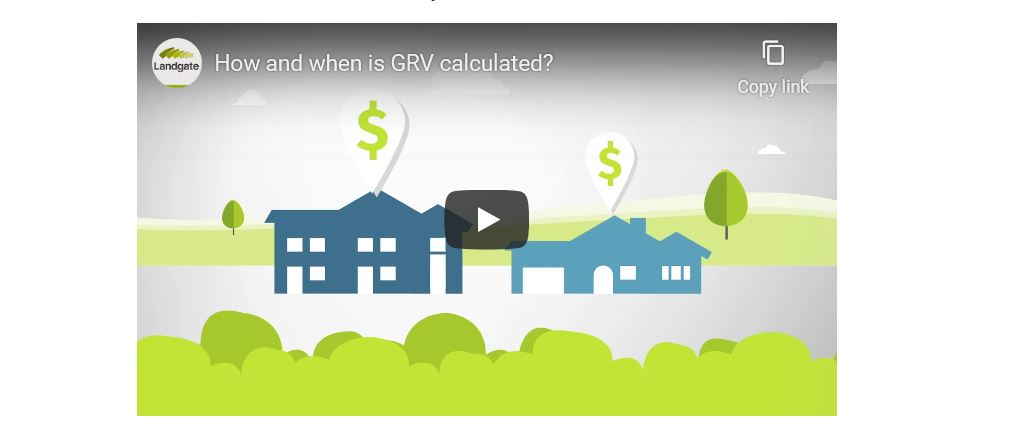On This Page
- What is Gross Rental Value (GRV)?
- Who uses the GRV?
- How and when is the GRV determined?
- How is the GRV determined for land with no buildings?
- Can my GRV be recalculated annually?
- What is considered when calculating the GRV?
- What happens when improvements or changes are made to my property?
- Are you concerned about your GRV?
The Gross Rental Value, or GRV, represents the gross annual rental that a property might reasonably be expected to earn annually if it were rented, including rates, taxes, insurance and other outgoings. For non-residential properties, GST is also included.
The GRV is calculated for all rateable and leviable properties in Western Australia regardless of whether the property is being rented or owner occupied.
Gross Rental Values (GRVs) are provided to rating authorities who use the GRV to work out rates, service charges and levies to be paid by property owners.
These rating authorities include:
- Local councils for rates
- Water providers (e.g. Water Corporation WA) for water and sewerage rates
- Department of Fire and Emergency Services (DFES) for the emergency services levy, which is included on your council rates
Each rating authority sets their own rate in the dollar to be charged. The rate in the dollar is multiplied by the GRV, with the local council adding any levies (e.g. rubbish collection) to calculate the total of rates payable. You should find details of the GRV and rate in the dollar used to calculate your rates in the bill notices received from the respective rating authority.
If you have any queries on the rate in the dollar or levies, please contact the respective local council or rating authority. Any further queries on the GRV, please contact Landgate’s Customer Service team.
All properties within a local government area are assessed at the same date. This date is used by valuers to ensure a fair and equitable assessment is completed for all properties at a given point in time. The assessment date, which is known as the date of valuation or DoV is conducted every 3 years for the metropolitan area and 3 to 6 years for regional areas, depending on the local government. The Gross Rental Value (GRV) remains in force for the respective 3 to 6 year period, until the next GRV is calculated.
Find details of the most recent date of valuation for metropolitan and regional areas.
Valuers at Landgate collect rental evidence at the date of valuation. The rental evidence is analysed to establish property market levels, with individual property attributes considered to determine a fair rental value for each property.
Given the time it takes to collect and analyse evidence and calculate new GRVs for all Western Australian properties, there is a delay between the date of valuation and the date the valuations are applied by local governments. For local governments located in the metropolitan area this timeframe is 23 months between the date of valuation and the effective date (when they can apply the valuation to generate rates, taxes or charges). For local governments located in regional areas this timeframe is 11 months.

The diagram below represents the timeline of a GRV calculated every 3 years. The date of valuation (in this case 1 August 2021) is the date all properties within a local government area are assessed at, to determine GRVs. The effective date (in this case 1 July 2023) is the date the GRV is applied by local governments and other rating authorities. You can see how the GRV is applied to your rates notice over a 3 year period.
For more information, watch our GRV Videos.
For land that is undeveloped, a Gross Rental Value (GRV) is still determined by Landgate. As rental evidence cannot be used for this assessment, a statutory valuation of three per cent of the Unimproved Value is applied to properties designated as residential and five per cent for properties designated as non-residential.
These assessments are conducted in line with the GRVs generated from rental evidence and have the same date of valuation. This date is used by valuers to ensure a fair and equitable assessment is completed for all properties at a given point in time.
The diagram above represents the timeline of a GRV calculated every 3 years, which applies to the Perth metropolitan area and some WA regional local governments. Other WA regional local governments are assessed on a 3 to 6 year period, as deemed suitable by the Valuer-General.
The date of valuation (in this case 1 August 2018) is the date all properties within a local government area are assessed at, to determine a GRV. The effective date (in this case 1 July 2020) is the date the GRV is applied by local councils or other rating authorities. You can see how the GRV is applied to your rates notice over a 3 year period.
Landgate conducts over 2.4 million valuations (as at 1 July 2021) on land in Western Australia with a growth rate of 1.0% to 1.5% per annum. Due to the volume of valuations and expansive land area of Western Australia to be covered, it has been deemed by the Valuer-General that the most cost-effective approach is to conduct Gross Rental Values (GRVs) on a 3 year basis for the metropolitan area and 3 to 6 years for regional areas, depending on the local government. Completing valuations on a more frequent basis would see higher rates and charges for Western Australians.
Several attributes and constraints are considered when determining the Gross Rental Value (GRV) of a property. These may include:
Residential
- Location
- Age, building area and construction materials
- Number of bedrooms and bathrooms
- Number of car shelters (carports / garages)
- Below ground pools
- Views, busy roads, or proximity to an industrial precinct.
Non-residential
- Location
- Age, building area and construction materials
- Street exposure and property access
- Proximity to main arterial roads and primary commercial precincts.
Your local council or water provider will advise Landgate of any additions, improvements or demolitions, subdivisions, or amalgamations that have been actioned on your property.
Landgate valuers will review rental evidence as at the latest date of valuation, updating the Gross Rental Value (GRV) to reflect the changes that have been made to your property as if they were in place as at the latest date of valuation.
The new GRV will be provided to the rating authorities, which includes your local council, who will recalculate your rates and taxes for the remaining period in the current financial year. A rates or taxes adjustment notice will be issued by the rating authority advising of any additional charges or if a refund is due to you.

The diagram represents the timeline of an interim GRV within a GRV 3 year period, which applies to the Perth metropolitan area and some WA regional local governments. Other WA regional local governments are assessed on a 3 to 6 year period, as deemed suitable by the Valuer-General.
The date of valuation (in this case 1 July 2021) is the date all properties within a local government area are assessed at, to determine a GRV. The effective date (in this case 1 July 2023) is the date the GRV is applied by local councils or other rating authorities. You can see how the GRV is applied to your rates notice over a 3 year period. An interim valuation request (in this case on 25 February 2019) will require Landgate valuers to review your GRV using rental evidence on like properties as at the current date of valuation (in this case 1 August 2015).
After reviewing the information on the Landgate website, if you still have any inquiries or concerns about the Gross Rental Value (GRV), please contact the Landgate Customer Service Team.
If your concern is unresolved, the Landgate Customer Service team may direct you to lodge a formal objection on your GRV. For more information on how to lodge an objection, please visit the objections page.



X Verge Collection Delays – Bulk Waste and Green Waste READ MORE
X Main Administration Closed Until Monday 29 July READ MORE